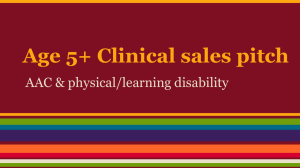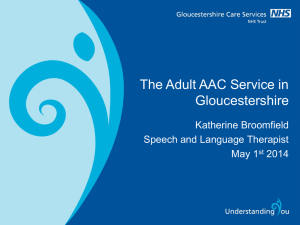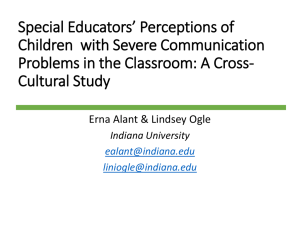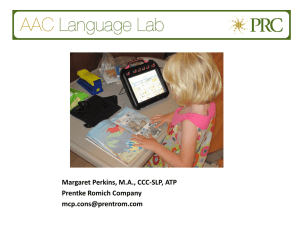AAC - March 1, 2013
advertisement
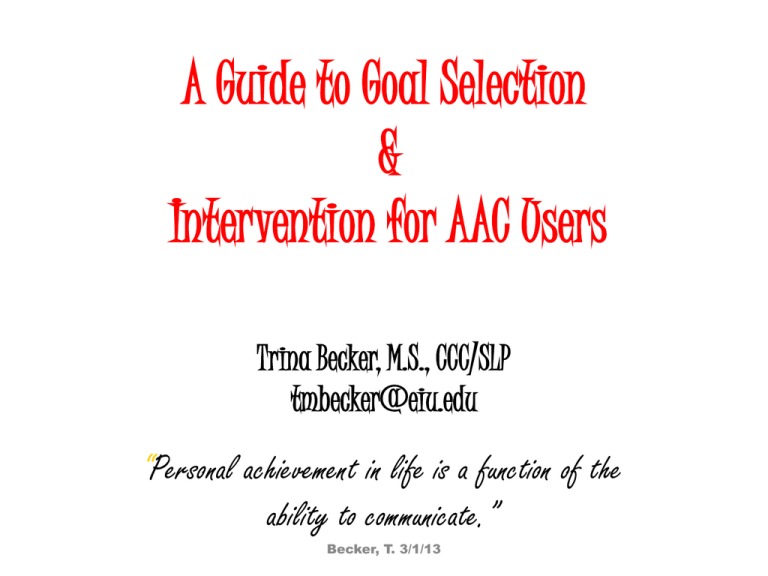
A Guide to Goal Selection & Intervention for AAC Users Trina Becker, M.S., CCC/SLP tmbecker@eiu.edu “Personal achievement in life is a function of the ability to communicate.” Becker, T. 3/1/13 What is AAC? • Refers to ways other than speech that are used to send a message from one person to another • Includes: – Gestures – sign language – facial expressions – picture symbol or alphabet boards – sophisticated computer systems Becker, T. 3/1/13 Benefits of AAC • • • • • • Provides means to communicate Increases participation & improves self-concept Facilitates learning Improves/restores receptive and expressive language Reduces frustration and behaviors Facilitates speech Becker, T. 3/1/13 Who uses AAC? • Anyone who has significant difficulty using speech to communicate • Used by people of all ages and disabilities • Etiology either acquired or congenital Becker, T. 3/1/13 Individuals who use AAC • Developmental Disabilities – Cerebral Palsy – PDD – Mental Impairment – Developmental Apraxia of Speech • Neurodegenerative Diseases (ALS, MS) • Acquired Disorders (TBI, Aphasia) Becker, T. 3/1/13 Classification of AAC Users Becker, T. 3/1/13 Classification of AAC Users • • • • • Emerging Communicator Wants/Needs Communicator Context-Cue Dependent Communicator Transitional Communicator Independent Communicator Adapted from Garrett (1992) and Beukelman (1998) Becker, T. 3/1/13 Communication Ability Levels Respects the fact that individuals with complex communication needs fall on a broad spectrum. Uses characteristics of individuals with complex communication needs to determine placement on the continuum. The InterAACT Framework (P. Dowden): DynaVox http://depts.washington.edu/augcomm/03_cimodel /commind1_intro.htm Emergent Context-Dependent Becker, T. 3/1/13 Independent Emerging Communicator • Does not reliably use symbolic communication • Relies primarily on nonsymbolic communication (gestures, vocalizations, etc.) • Emerging does not always = beginner • May also display – Minimal turn-taking (object) – Limited or no joint attention Becker, T. 3/1/13 Wants/Needs Communicator • Identifies basic symbols • Do not have a wide range of vocabulary • Uses symbols to make choices and meaningful requests objects • Primarily uses 1 symbol at a time • Does not use symbols to interact socially only for wants/needs Becker, T. 3/1/13 Context Cue Communicator • Vocabulary includes nouns, pronouns, verbs, some descriptors • Combines symbols to produce phrases • Produces socially appropriate comments • Participates in structured conversations with familiar partners • Appropriately answers routine questions with prompts Becker, T. 3/1/13 Transitional Communicator – Initiates conversations and social interactions with familiar partners – Answers questions of unfamiliar partners without prompts – Not comfortable initiating interactions with unfamiliar partners and using AAC in unfamiliar settings – Creates novel utterances – Recognizes conversational breakdowns and uses repair strategies with mod cues Becker, T. 3/1/13 Independent Communicator • Understands communication the same as same-aged peers • Appropriately uses AAC system to communicate across all environments independently the same as peers • Generates novel utterances • Effectively uses repair strategies to fix communication breakdowns • Independent in operational competence (as much as physical ability will allow) Becker, T. 3/1/13 Levels of Communication Children with Dev. Disabilities • Follows typical hierarchy – Emerging Communicator – Wants/Needs Communicator – Context-Cue Dependent Communicator – Transitional Communicator – Independent Communicator Adapted from Garrett (1992) and Beukelman (1998) Becker, T. 3/1/13 Technology Access Display AAC System Language Representation Output Becker, T. 3/1/13 Technology No tech Low tech Mid tech High tech Becker, T. 3/1/13 No Tech Systems Becker, T. 3/1/13 Low Tech Systems Mid Tech Systems Becker, T. 3/1/13 High Tech Devices Becker, T. 3/1/13 Technology Access Display AAC System Language Representation Output Becker, T. 3/1/13 Language through Symbols • Symbol – “something that stands for something else” ( Anderheiden & Yoder, 1986, pg. 15) –Single meaning –Icon – based –orthographic Becker, T. 3/1/13 Single meaning DynaSyms – DynaVox PCS – Boardmaker Proloquo2Go – iPad Symbolstix – Tobii - ATI Icon • Unity Language – Prentke Romich Orthographic Becker, T. 3/1/13 Levels of Communicators & Levels of AAC NOTE: High tech devices can be adjusted to meet any communication ability level No to Low Tech Emerging communicators Low Tech to High Tech Wants/needs communicator Base decision on individual Trials, Trials, Trials! Mid tech to High Tech Context-Cue Dependent Communicator Transitional Communicator Becker, T. 3/1/13 Independent Communicator Continuum of Intervention Becker, T. 3/1/13 Intervention goals • Goals should be chosen to build communication skills to the next level of the AAC continuum Emergent Wants/needs Context Cue Becker, T. 3/1/13 Transitional Independent Communicative Competence “the ability to communicate functionally in natural environments to meet daily communication needs” (Light, 1989) Linguistic Social Operational Strategic Becker, T. 3/1/13 Ultimate Goal Whatever Whomever Becker, T. 3/1/13 Wherever What’s your ultimate goal? • How are you going to get your client to be able to tell you what they are thinking? • How are you going to get them competent communicating in a variety of situations with a variety of communication partners? • Consider functional vs developmental • Consider communication skills vs discrete language skills Becker, T. 3/1/13 LEVEL ONE COMMUNICATOR Emerging Communicator – Develop symbolic Communication – Understand Cause and Effect – Make meaningful choices – Make meaningful requests – Develop turn-taking (object) – Increase initiation – Use greetings hi/bye – Build receptive knowledge of picture symbols Becker, T. 3/1/13 LEVEL TWO COMMUNICATOR Wants/needs Communicator – – – – – – – – – Begin to combine symbols to make 2 word utterances Expand types of requests Make socially approp. comments with prompts Answer routine questions with prompts Expand vocabulary/symbols – verbs/nouns/adjectives Increase spontaneous use of greetings (hi/bye) Effectively and efficiently locate symbols on AAC system Demonstrate ownership of device Gain attention of communication partner Becker, T. 3/1/13 LEVEL THREE COMMUNICATOR Beginning of Context-Cue Communicator – Combine symbols to make phrases with minimal cues – Use comments with minimal cues in routine activities – Engage in short social interactions/conversations with familiar partners with mod - max cues – Expand vocabulary (questions, adjectives, verbs) – Use function symbols on AAC system (clear, delete, etc) – Navigate through communication system (dynamic) with prompts – Learn to adjust volume based on environment – Recognize communication breakdowns with prompts Becker, T. 3/1/13 LEVEL FOUR COMMUNICATOR Middle to end of Context Cue Communicator – – – – – – – – – – Initiate conv/social interactions with familiar partners Produce novel utterances Expand utterance length Develop morphology Continue to expand vocabulary Answer questions and participate in conversations without prompts Recognize conversational breakdowns Use strategies to repair breakdowns with prompts Navigate through communication system with prompts Introduce programming (if appropriate) Becker, T. 3/1/13 LEVEL FIVE COMMUNICATOR Transitional Communicator – – – – – – Encourage use of AAC across all environments Increase comfort level in unfamiliar situations If appropriate, continue to develop morphology Increase independence in using repair strategies Encourage programming to increase independence Encourage independence in operational functions (volume control, maintenance of system) Becker, T. 3/1/13 Resources for Goal Selection • Dynamic AAC Goals Planning Guide – DynaVox: Implementation Toolkit • Prentke Romich – AAC Language Lab – http://www.aaclanguagelab.com/ • AAC Communication Profile (Tracy M. Kovach) – http://www.linguisystems.com/products/product/ display?itemid=10547 Dynamic AAC Goals Grid Choosing and Writing Appropriate Goals Becker, T. 3/1/13 Increasing Complexity of Goals • Do you have clients who seem to work on the same goal forever? • How we can we increase complexity? – Level of prompting – Different activities – Different environment – Different communication partners Becker, T. 3/1/13 Prompting Hierarchy • • • • Physical assistance (PA) Direct Pointer Cue (DPC) Direct Verbal Cue (DVC) Indirect Cue (IC) Becker, T. 3/1/13 • Chain of cues Hierarchy of Activities Defined structured activity Various structured activities Unstructured activities Becker, T. 3/1/13 Hierarchy of Activities • Routine structured activity (activity used to teach the skill) – Requesting – snack activity • Various structured activities – Want client to be able to use skill in a variety of structured activities – Requesting – Mr. Potato head, puzzle pieces, blocks Becker, T. 3/1/13 Levels of Communication Partners Hierarchy of Communication Partners • Teacher/therapist (individual teaching skill) • Familiar adult or peer – Start with partner client is most comfortable with • Unfamiliar Becker, T. 3/1/13 Hierarchy of Environments Community Home Classroom Therapy room Becker, T. 3/1/13 Hierarchy of Environments • Environment in which skill is taught – Therapy room – Classroom • Environment client is highly familiar with – Classroom – Home – May even move around different areas in familiar environment Becker, T. 3/1/13 Hierarchy of Environments Cont’d • Unfamiliar Environments (not a part of daily routine) – Places in the community • • • • Grocery store Movie theater Doctor’s office Restaurant Becker, T. 3/1/13 Dynamic Goal Includes… • ALL 4 COMPLEXITY LEVELS Client will __(skill)__ during __(activity)__ in __(environment)__with __(partner__ with ___(prompting)__with ___% accuracy. Becker, T. 3/1/13 Writing Dynamic Goals… • Allows for easier tracking of progress • Provides justification for targeting “same goal” over time • Develops communicative competence and independent communication Becker, T. 3/1/13 Intervention Strategies Becker, T. 3/1/13 Basic Communicative Functions • • • • Attention seeking Acceptance/rejection Choice making Requesting Becker, T. 3/1/13 Teaching Offered Choice Making • • • • Opportunities Objects Symbols Choice making formats – natural env. Choice making Arrays – 2 preferred – 1 preferred, 1 nonpreferred – Preferred, blank/distractor Becker, T. 3/1/13 Teaching Offered Choice Making • Must always follow through with choice! • Present objects followed by symbols • Present symbols followed by objects Becker, T. 3/1/13 Strategies to Teach Requesting • Mileau teaching interventions – Incidental – unstructured, initiation – Mand-Model - adult initiated, prompted – Time-Delay – behav established, initiation • • • • Interrupted behavior chains Missing/out of reach item Verbal prompt-free PECS Becker, T. 3/1/13 Why does intervention stop with requesting? Need to be able to say more than… How do typically developing children learn language? WHERE? WHEN? WHAT? WHO? Intervention Strategies • • • • • • • Aided AAC modeling Expectant delay Open-ended questions Recasting Sentence Strips Structured practice Social Stories Becker, T. 3/1/13 Aided Language Modeling • Aided Language Stimulation – A teaching strategy in which the facilitator highlights symbols on the user’s communication display as he interacts and communicates verbally with the user. (Goossens, Crain & Elder, 1992) • Mimics the way typically developing children learn language • Also referred to as… – Aided language modeling – Augmented input – System for Augmenting Language (VOCA) Becker, T. 3/1/13 Knowing the device – Learning to use AAC device is like learning another language – Any successful teacher needs to be knowledgeable and fluent in what they are teaching Becker, T. 3/1/13 Other Benefits of ALM Helps establish and build joint attention between device and communication partner, and device and stimulus (Video) Takes pressure off the AAC user to always “perform” Educates the communication partners regarding location of symbols and appropriate Teaching reciprocal interactions – more like a natural conversation. A most to least cueing hierarchy for increased success. Becker, T. 3/1/13 Expectant Delay • Increased pause time during interaction to prompt child to communicate while maintaining eye contact and expectant facial expression Wait for it…. Becker, T. 3/1/13 Open Ended Questions • Asking open ended questions will … – Facilitate use of symbols – Prompt higher-content communication – Allow user to demonstrate knowledge – Facilitate turn taking • Don’t ask so many yes/no questions! Becker, T. 3/1/13 Recasting • Expand child’s utterance to add new information (model more advanced language) – Expand utterance – Use more specific vocabulary – Add word endings (-s, -ing, -ed) Car! → Go Car! → Go racecar! → Go faster racecar! Flower → Pretty flower → Pretty rose → You smelled the pretty rose. Sentence Strips/Visual cues • Allows AAC user to see what they are expected to produce. – Helps make expectations clear • Can be used for both low tech and high tech • Important to fade so client develops independence Becker, T. 3/1/13 Structured Practice • Linguistic competency – higher level language skills (syntax, morphology) • Social competency – conversational skills (role play) Becker, T. 3/1/13 Social Stories • Typically used to teach skills such as pragmatics, problem solving, etc. • Can be used with AAC to teach appropriate interactions and symbol selection • Video Modeling Becker, T. 3/1/13 Tri-Focused Framework (Siegel-Causey & Bashinski, 1997) AAC User Environment Communication Partner Becker, T. 3/1/13 What would make a child a successful communicator? • Use of a device across environments and across communication partners. • Ability for your child to engage in variety of interactions and activities of their choice. • Interventionists who are considering building those skills across all environments and partners. Becker, T. 3/1/13 Traditional AAC therapy • Traditionally, AAC intervention has focused on improving only AAC user’s skills • Because of this “traditional model” we are seeing a lack of success in carryover and even AAC abandonment for some children. • AAC abandonment occurs when there is a lack of carryover across partners and environments. • It is just not functional to use with 1 partner in 1 place. Becker, T. 3/1/13 Factors of AAC Abandonment • Negative impact on life and family stress • Lack of opportunities and support • Lack of training Becker, T. 3/1/13 Survey says…. • Parents want a partnership with professionals working with their children • Parents want us to consider their family a unique case regarding training and goal selection • Parents want us to face the reality of parenting a individual with special needs when providing recommendations • Parents want information!!! Becker, T. 3/1/13 We can’t forget! • Parents know their child better than we ever could • Parents are with child in more environments than we are • Carry over outside of any therapy setting is a must! CONSIDER THIS…. Teaching a skill for ONLY 45 minutes, twice a week will take over 40 years to master Becker, T. 3/1/13 Importance of family involvement • Family is the essential context for language learning and communication development • Primary communication partners for AAC users • Provide essential social experiences and practice opportunities for developing social and communication competence Becker, T. 3/1/13 Family-Centered Intervention • Priorities and choices of family drive intervention – Family focus of services – Families decide what is important – Provide services to families • The process of actively involving the entire family in treatment of a child with a disability (Rainforth & York-Barr, 1997) Becker, T. 3/1/13 AAC Boot Camp: Research on impact of involving parents in intervention process Stephanie Fanale, B.S. – graduate student Trina Becker, M.S., CCC/SLP – faculty mentor Beth Bergstrom, CCC/SLP – faculty mentor Eastern Illinois University, Summer 2012 Becker, T. 3/1/13 Independent Variable • Informational meeting – General AAC training—1.5 hours • • • The benefits of AAC The necessity for AAC use in all environments A general overview of the strategies that will be taught during the program – Operational skills training—1.5 hours • • • Conducted by representatives of AAC device companies (i.e., Prentke Romich, DynaVox) Communication partners were divided into groups based on the AAC device used by their AAC users. Training included: – • Trouble shooting, programming, and basic operational features of the AAC devices Two weeks of training sessions – Week one: • 3 training sessions targeting aided language modeling and recasting—2 hours each session – Week two: • 3 training sessions targeting asking open-ended questions and expectant delay—2 hours each session – Each training session included: • • • • • Time for the communication partners to share their experiences Discussion of why and how to implement the targeted strategies Observation of the SLPs on how to implement the strategies Supported practice Independent implementation of the strategies during play (15 minutes) Fanale, 2012 Dependent Variables • Data collection for communication facilitating strategies: – 3 home observations were videotaped and reviewed for each participant prior to initiation of the communication partner training program – During training—1 observation was videotaped each session – Six weeks post-training—3 home observations were videotaped – Each observation was 15 minutes and used the same toy set across participants • Survey included questions regarding: – – – – – Demographic information Previous AAC training Views of AAC Use of AAC in the home A rating of the saliency, frequency, and feasibility of incorporating AAC in everyday home activities using a 5-point scale (1= never; 5 = always). T. 3/1/13 – The survey was completed priorecker, to the training and six-weeks post training Strategies taught at boot camp • Aided Language Modeling • Recasting • Asking Open-ended Questions • Expectant Delay Results Results Results Results Data from 2 of the students # of Communication Symbols # of Independent Initiations & Responses Column1 Column2 45 40 35 30 25 20 15 10 5 0 Baseline Treatment Maintenance Conclusion • Overall, participants increased their use of communication facilitating strategies with their children • ALM was the easiest strategy for the participants to learn and retain • Expectant delay and recasting were the most difficult strategies for the participants to use consistently • Individual differences and skill levels of the AAC users contributed to the participants’ performances – E.g., Participants 1, 3, and 4 had AAC users who initiated use of their AAC devices, therefore providing opportunities for the participants to use recasting, while participants 2 and 5 had limited opportunities Fanale, 2012 Participant Quotes from Boot Camp • “Thanks for making me realize the disservice I have been doing to my child all these years” (participant 1) • “When playing with my child, I now think about and see sequences that I can use on the device” (Participant 2) • “I didn’t realize how important it was that I used her talker until I started doing this boot camp and saw how much this helps her”(Participant 3) • “I am surprised at how much he has changed” (Participant 4) • “He has changed more in two weeks of boot camp than he did in a year of traditional therapy” (Participant 4) • “I am going to do my own boot camp at my house with the teachers and educators at his school” (Participant 5) Fanale, 2012 Conclusion Conclusion! Becker, T. 3/113 Conclusion Trial lots of devices! -consider preferences -find language system that best fits -think about functional vs developmental Becker, T. 3/1/13 Choose goals to build Communicative competence! - 4 areas of competency - Consider a continuum - Increase complexity Becker, T. 3/1/13 Choose intervention strategies that work! ALM Use language intervention you are familiar with and incorporate AAC! Becker, T. 3/1/13 Involve Communication Partners!! Most want to be involved! I want specific, individualized assistance. Help me! Becker, T. 3/1/13 Websites • • • • • http://www.dynavoxtech.com/ http://www.prentrom.com/ http://www.assistivetech.com/ http://www.aacinstitute.org/ http://aac.unl.edu:16080/yaack/toc.html (AAC Connecting Young Kids) • http://www.aacintervention.com/ • http://www.gatewaytolanguageandlearning.com/ • http://aac.unl.edu/vocabulary.html (vocabulary lists) • http://www.lburkhart.com/ • www.creativecommunicating.com • www.mayer-johnson.com Becker, T. 3/1/13 EBP for Aided Language Modeling • • • • Colgan, (2008). Aided language modeling and requesting behavior in two preschool children with autism. Unpublished undergraduate thesis, Eastern Illinois University. Drager, K.D.R., Postal, V.J., Carrolus, L., Castellano, M., Gagliano, C., & Glynn, J. (2006). The effect of aided language modeling on symbol comprehension and production in 2 preschoolers with autism. American Journal of Speech-Language Pathology, 15, 112-125. Harris, M.D. & Reichle, J. (2004). The impact of aided language stimulation on symbol comprehension and production in children with moderate cognitive disabilities. American Journal of Speech-Language Pathology, 13, 155-167. Light, J. (1989). Toward a definition of communicative competence for individuals using augmentative and alternative communication systems. Augmentative and Alternative Communication, 5, 137-143. Becker, T. 3/1/13 Other Resources • Beukelman, D. & Mirenda, P. (2005) Augmentative and alternative communication supporting children and adults with complex communication needs. Brookes Publishing Co., Baltimore, MD. • Light, J., Beukelman, D. & Reichle, J. ( 2003) Communicative competence for individuals how use AAC. Brookes Publishing Co., Baltimore, MD. • Light, J. & Drager, K. (2007) Evidence-based AAC interventions for Infants, Toddlers, and Preschoolers. Presentation at ASHA, Boston. • Clarke, V. & Schneider, H. Beyond Eat, Drink & Potty (2007) Presentation at Closing the Gap, Minneapolis. Becker, T. 3/1/13 References from Boot Camp Study • • • • • • Bruno, J., & Dribbon, M. (1998). Outcomes in AAC: Evaluating the effectiveness of a parent training program. AAC: Augmentative and Alternative Communication, 14(2), 5970. doi:10.1080/07434619812331278216 Carter, M., & Maxwell, K. (1998). Promoting interaction with children using augmentative communication through a peer-directed intervention. International Journal of Disability, Development And Education, 45(1), 75-96. Kent-Walsh, J., & McNaughton, D. (2005). Communication partner instruction in AAC: Present practices and future directions. AAC: Augmentative and Alternative Communication, 21(3), 195-204. doi:10.1080/07434610400006646 Light, J. (1989). Toward a definition of communicative competence for individuals using augmentative and alternative communication systems. AAC: Augmentative and Alternative Communication, 5(2), 137-144. doi:10.1080/07434618912331275126 Siegel-Causey, E., & Bashinski, S. M. (1997). Enhancing initial communication and responsiveness of learners with multiple disabilities: A tri-focus framework for partners. Focus on Autism and Other Developmental Disabilities, 12(2), 105-20. Starble, A., Hutchins, T., Favro, M., Prelock, P., & Bitner, B. (2005). Family-centered intervention and satisfaction with AAC device training. Communication Disorders Quarterly, 27(1), 47-54. doi:10.1177/15257401050270010501 Becker, T. 3/1/13




